The product development process at Golden Artist Colors is a constant collaboration between artist and paintmaker. Over time, this has resulted in the wide array of painting tools offered for today’s professional artist. We are always in a state of continuous improvement of current products as well as creating new ones that benefit the artist. For 2019 we offer unique products, a new studio tool, and a newly designed tube cap.
NEW PAINT TUBE CAPS
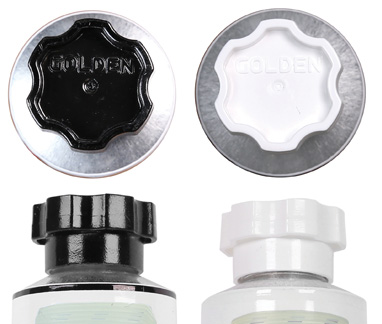 Sometimes the best improvement to make isn’t made to the actual product, but its delivery device: the ubiquitous tube cap. The current caps can be a bit challenging to twist off, so we added some gripping power with a “Deep Cog” design. In the spring of 2019 we’ll begin rolling out Heavy Body Acrylics and OPEN Acrylics paint tubes with redesigned caps. The new cap makes it easier to get a grip and provide some substance to hold onto. Marketing Director Matt Cleary aptly describes the new tube cap as “snow tires for your fingers!”
Sometimes the best improvement to make isn’t made to the actual product, but its delivery device: the ubiquitous tube cap. The current caps can be a bit challenging to twist off, so we added some gripping power with a “Deep Cog” design. In the spring of 2019 we’ll begin rolling out Heavy Body Acrylics and OPEN Acrylics paint tubes with redesigned caps. The new cap makes it easier to get a grip and provide some substance to hold onto. Marketing Director Matt Cleary aptly describes the new tube cap as “snow tires for your fingers!”
PAINT TUBE CAP TOOL
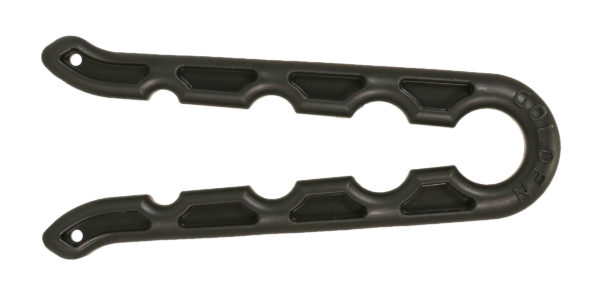 Along with a new tube cap, we unveil a nifty tube opening device called the GOLDEN GRIPR™ Cap Tool. The Gripr™ is made from durable yet flexible ABS plastic and can be used on a variety of paint caps. It can be used with both old and new style GOLDEN paint tubes, as well as Williamsburg Oil and QoR® Modern Watercolor tubes. The Gripr™ is easy to use and provides leverage to remove even the most stubborn caps. The tool will be available in stores that sell GOLDEN products.
Along with a new tube cap, we unveil a nifty tube opening device called the GOLDEN GRIPR™ Cap Tool. The Gripr™ is made from durable yet flexible ABS plastic and can be used on a variety of paint caps. It can be used with both old and new style GOLDEN paint tubes, as well as Williamsburg Oil and QoR® Modern Watercolor tubes. The Gripr™ is easy to use and provides leverage to remove even the most stubborn caps. The tool will be available in stores that sell GOLDEN products.
COLOR POURING MEDIUM
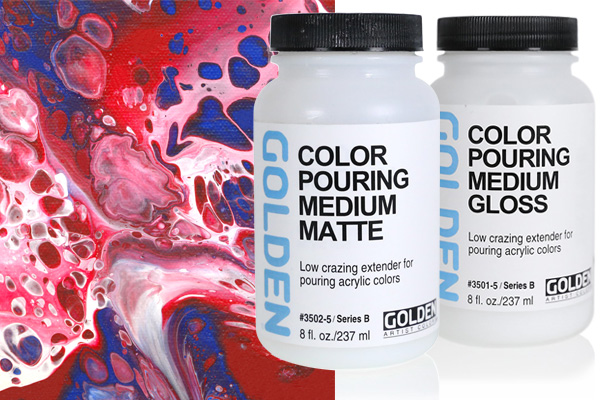 Using gravity to direct liquid paints to flow isn’t a new technique. However, the following two new pourable acrylic mediums are. Making their debut in 2019, Color Pouring Mediums are intended to be blended as desired with either Fluid or High Flow Acrylic paints. The most unique of these products is our Color Pouring Medium Matte. Typical pouring blends end with a high gloss finish, while our new matte product changes the dynamics for artists experimenting with pours. Other paints may be blended with these mediums, but Fluids and High Flow Acrylics are ideally suited to blend with the Color Pouring Mediums. In order to learn the working properties of these mediums, begin at a simple 10:1 (medium to paint) ratio. Refer to our website for further information.
Using gravity to direct liquid paints to flow isn’t a new technique. However, the following two new pourable acrylic mediums are. Making their debut in 2019, Color Pouring Mediums are intended to be blended as desired with either Fluid or High Flow Acrylic paints. The most unique of these products is our Color Pouring Medium Matte. Typical pouring blends end with a high gloss finish, while our new matte product changes the dynamics for artists experimenting with pours. Other paints may be blended with these mediums, but Fluids and High Flow Acrylics are ideally suited to blend with the Color Pouring Mediums. In order to learn the working properties of these mediums, begin at a simple 10:1 (medium to paint) ratio. Refer to our website for further information.
Color Pouring Mediums can be used to create both opaque and translucent paint layers with excellent control during painting. Both are exceptionally adept for paint puddles and “pancake pours” with little risk of cracks or crazes. Mixtures can be stored and applied using a variety of tools and techniques.
Color Pouring Medium Gloss readily flows onto the painting surface, generating uniform pools of paint. The dried surface of Color Pouring Medium Gloss (CPM Gloss) is smooth and shiny. Adjusting the amount of paint added to CPM Gloss controls saturation and opacity. Mixtures can be used in a variety of techniques, with crisp color boundaries that respond to tilting and gentle persuading. Add small paint additions to create veils of translucent color over previously painted passages.
Color Pouring Medium Matte: If you are not a fan of high gloss paint surfaces, then check out Color Pouring Medium Matte (CPM Matte). This moderately viscous leveling medium allows for uniform color fields without brush or tool marks. It drips and drizzles with ease. Air bubbles readily rise and pop during drying. Although CPM Matte is quite flat, colors remain deep and vibrant. Surprisingly, even Iridescent and Interference Colors retain a great amount of luster.
ISOLATION COAT
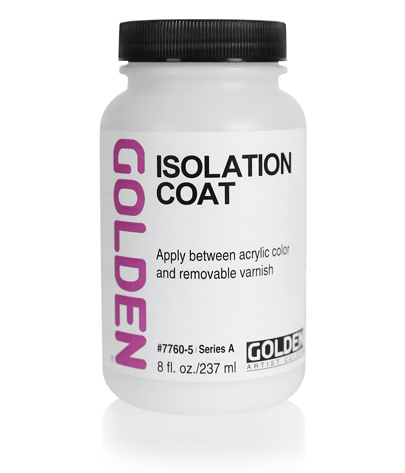 The new Isolation Coat is a ready-to-use sealing coat for acrylic paintings. Previously acrylic artists’ only recourse was to dilute Soft Gel Gloss with water (our former and still acceptable recommendation) before applying it to completed acrylic artwork. The new Isolation Coat takes the guesswork out of measuring and mixing, with increased flow and leveling and may be applied during any part of the painting process. Finishing a painting with isolation coat and varnish provide ongoing protection for your artwork from the hands of time. Isolation coat is a permanent acrylic medium that seals surface absorbency and allows for improved varnish application and easier varnish removal. Apply one or more layers before varnishing.
The new Isolation Coat is a ready-to-use sealing coat for acrylic paintings. Previously acrylic artists’ only recourse was to dilute Soft Gel Gloss with water (our former and still acceptable recommendation) before applying it to completed acrylic artwork. The new Isolation Coat takes the guesswork out of measuring and mixing, with increased flow and leveling and may be applied during any part of the painting process. Finishing a painting with isolation coat and varnish provide ongoing protection for your artwork from the hands of time. Isolation coat is a permanent acrylic medium that seals surface absorbency and allows for improved varnish application and easier varnish removal. Apply one or more layers before varnishing.
SEMI-GLOSS ARCHIVAL SPRAY VARNISH
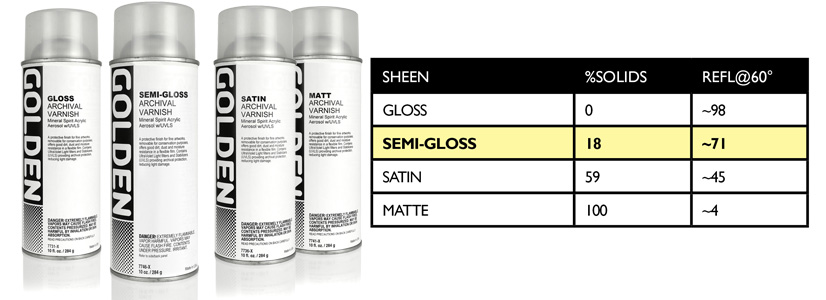
Finally we offer a new sheen of our aerosol varnish called Archival Varnish W/UVLS Semi-Gloss. It’s relatively easy when using MSA or Polymer Varnish to mix the Gloss and Satin varnishes together to create a semi-gloss, but that’s not an option when using spray can varnish. The new Semi-Gloss aerosol varnish serves to lower gloss yet retain color depth, making it ideal for a buildup of multiple coats. As with the previously offered sheens (Gloss, Satin and Matte) Semi-Gloss Archival Spray Varnish may be used on top of a variety of artist media, including acrylic paint, oil, watercolor, ink-jet prints and collage.
These products are the result of listening to you: our customers. If you have any questions about these tools or any of our products or specific applications – contact the Material and Application Specialists at 800-959-6543, [email protected] or via social media. Also visit goldenpaints.com for new product information and videos.
About Michael Townsend
View all posts by Michael Townsend -->Subscribe
Subscribe to the newsletter today!
No related Post

I was wondering what the difference is between GAC 800 and the new pouring mediums (especially the new Gloss medium as I know the matte finish is new). Is the new Pouring Medium a combination anti-crazing/leveling formulation so that one would not have to add a leveling agent (kind of a GAC 800 + Floetrol concept)? Or something else? Thanks!
Hello Lori.
Thank you for your questions. The GAC 800 and the new Color Pouring Medium Gloss are currently based on same resin but that we anticipate improving the pouring medium over time. At present the two products will perform similarly and a person who has GAC 800 currently can continue to use it.
The CPM Gloss doesn’t have a great deal of leveling (usually in the form of a thickener as we use in our Clear Tar Gel and other long rheology products) but the CPM Matte readily levels out when applied. Floetrol is a commercial housepaint additive, and should not be necessary to use with these mediums. You can blend the CPM Gloss with the CPM Matte, which would improve the Gloss’ leveling ability.
– Mike Townsend
I’m looking forward to the new caps. Honestly, it’s the only critique I have about your paint is the cap. And the semi gloss spray and isolation coat are definitely on my list to try!
That’s great to hear Dori.
We hope these products meet or exceed your expectations!
– Mike Townsend
Yes, I’m tired of using my teeth
Thank you! Thank you! For the already prepared Isolation Coat.
You are most welcome Christine. the premixed Isolation Coat has been a long time coming!
– Mike Townsend
Hooray for redesigned caps!!! So happy to hear this! 😃👩🎨
Thank you Barb!
We are as well!
– Mike Townsend
I’m so happy to see the new caps. I have arthritis, and struggle with the current caps. Those should make a huge difference for me, and many others. Thank you <3
You are most welcome Sandy. We are excited that these caps will make a difference for many artists. Who hasn’t dealt with an extra tight cap that seems like it was welded onto the tube?
– Mike Townsend
Thank you for the new caps! How can I order just some caps? I am 70 yrs old and painting only for a year and I have over 30 Golden tubes with the old caps and I have a hard time working with them. I love the paint so much I tolerated the caps but now….on social security so can’t afford to throw them out.
Also when will the opener tool be available and where?
Thank you
Hello Sue.
Thank you for reaching out to us. We would be happy to send you some new caps for your paint tubes. I’ll email you so we can get the process started! The Gripper is going to be at stores that sell GOLDEN Paints and should be ready to purchase.
– Mike Townsend
Hi Michael,
I wonder if the new Isolation Coat would be suitable to use on gold leaf before painting on the gold (or silver etc.) leaf? And if yes, how many coats would you recommend?
Thank you,
Clementine.
Hello Clementine.
Thank you for your questions. Real Gold leaf would be fine, as it doesn’t tarnish from a waterbased product being applied. It would be a shame to cover and alter the exposed (unpainted) gold surface with acrylic medium, so be sure you are ok with the appearance on a test piece before you coat the actual painting. The other leaf materials – Silver, imitation gold, copper and bronze – are likely going to tarnish and develop a patina in the isolation coat layer. It is going to happen where you apply paint but that is hidden under the paint layer. Alternatively you can apply the isolation coat just in the areas to be painted, and then after the work is complete you can still cover the entire piece with the MSA Varnish or the spray version, Archival Varnish. Please contact us at [email protected] if you want to delve deeper into this process.
– Mike Townsend
Hi, great news about the redesigned caps. I would love to change the ones on my current tubes to the new style to ease the pain in my arthritic hands! How/where can I get some?
Thanks
Hello A. D.
Thank you for your commenting on this redesign. All you need to do is contact our Customer Service Department and they’ll get you started on the process. https://www.goldenpaints.com/contact_us/customer_service
– Mike Townsend
Hi! I need to know what kind of liquid cleaner to use on an un-varnished acrylic painting?
Many thanks, Luigi
Hello Luigi.
Thank you for commenting on this article. Cleaning acrylics is a bit complicated to try and explain in this response, but we have an excellent article also at JustPaint.org that should help you learn about the process: https://justpaint.org/techniques-for-cleaning-acrylic-paintings/
– Mike Townsend